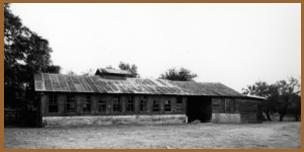Guide to SA Natural Areas & Greenway Trails
O. History of Voelcker Farm

Rendering courtesy of Phil Hardberger Park Master Plan as reproduced in
http://blog.mysanantonio.com/jeffcoyle/2011/03/volunteers-to-restore-historic-dairy-barn-at-phil-hardberger-park/
Alamo Area Master Naturalist Wendy Thornton wrote this piece from information contained in the book Last Farm Standing on Buttermilk Hill: Voelcker Roots Run Deep in Hardberger Park by Gayle Brennan Spencer, © 2010.
PHIL HARDBERGER PARK WAS ONCE THE SITE OF A DAIRY FARM
The Voelcker farm, which is now Phil Hardberger Park, was the homestead of Max and Minnie Alma Tomerlin Voelcker. Max and Minnie came from a large farming and ranching community about twelve miles north of San Antonio.
In the early days of the settlement numerous hardships were endured, including attacks by marauding Indians. Women and children were particularly vulnerable during the Civil War, when men were away fighting in the Confederate Army. Accessing water was another hardship. When nearby creeks ran dry, the only available water was at San Pedro Springs in San Antonio, a half day’s wagon ride distant.
If we didn’t have water available at the turn of a tap, would we be better conservators of this valuable resource?
MAX VOELCKER WORKED THE FARM & MINNIE DELIVERED THE MILK
Max was the son of dairy farmers and ranchers. After their marriage, Max continued to work the farm, while Minnie delivered milk to San Antonio. During the Great Depression of the 1930s, they began to wholesale their milk products to large dairies in San Antonio. Eventually, fierce dairy price wars in Texas led to a decline in prices. In 1947 the Voelckers sold their dairy cows and managed a living by raising meat cattle and leasing their land to hunters.
In 1971 Max and Minnie sold a large parcel of land, which allowed them to live more comfortably. Minnie lived for twenty years after the death of her husband. She passed away in 2000 at the age of 96. Six years later, the city of San Antonio purchased a large acreage of the Voelcker property. The following year the city obtained a subsequent parcel for a total of 311 acres.
PHIL HARDBERGER PARK IS A CULTIVATED URBAN WILDERNESS
This property was destined to become a green area for urban dwellers. Groundbreaking for Voelcker Park took place in February 2009. In December of that year the park was renamed Phil Hardberger Park in recognition of the former mayor who worked so diligently to make the park a reality.
WHAT DO YOU THINK "CULTIVATED URBAN WILDERNESS" MEANS?
What kind of park can be made from previous dairy and cattle land?
Phil Hardberger Park is a cultivated urban wilderness. It will become a living laboratory for the preservation of trees and the restoration of native savannas—a thoughtful stewardship of ecosystems and the environment. The park plan reserves 75% of the land for preservation and restoration. Programmed areas such as walking paths and outdoor rooms are combined with wild areas that establish a wildlife corridor to Salado Creek. The park provides a model of the peaceful coexistence of urban living and wilderness.
Photo courtesy of Dudley Harris ( http://blog.mysanantonio.com/jeffcoyle/ 2011/03/volunteers-to-restore-historic-dairy-barn-at-phil-hardberger-park/ )
